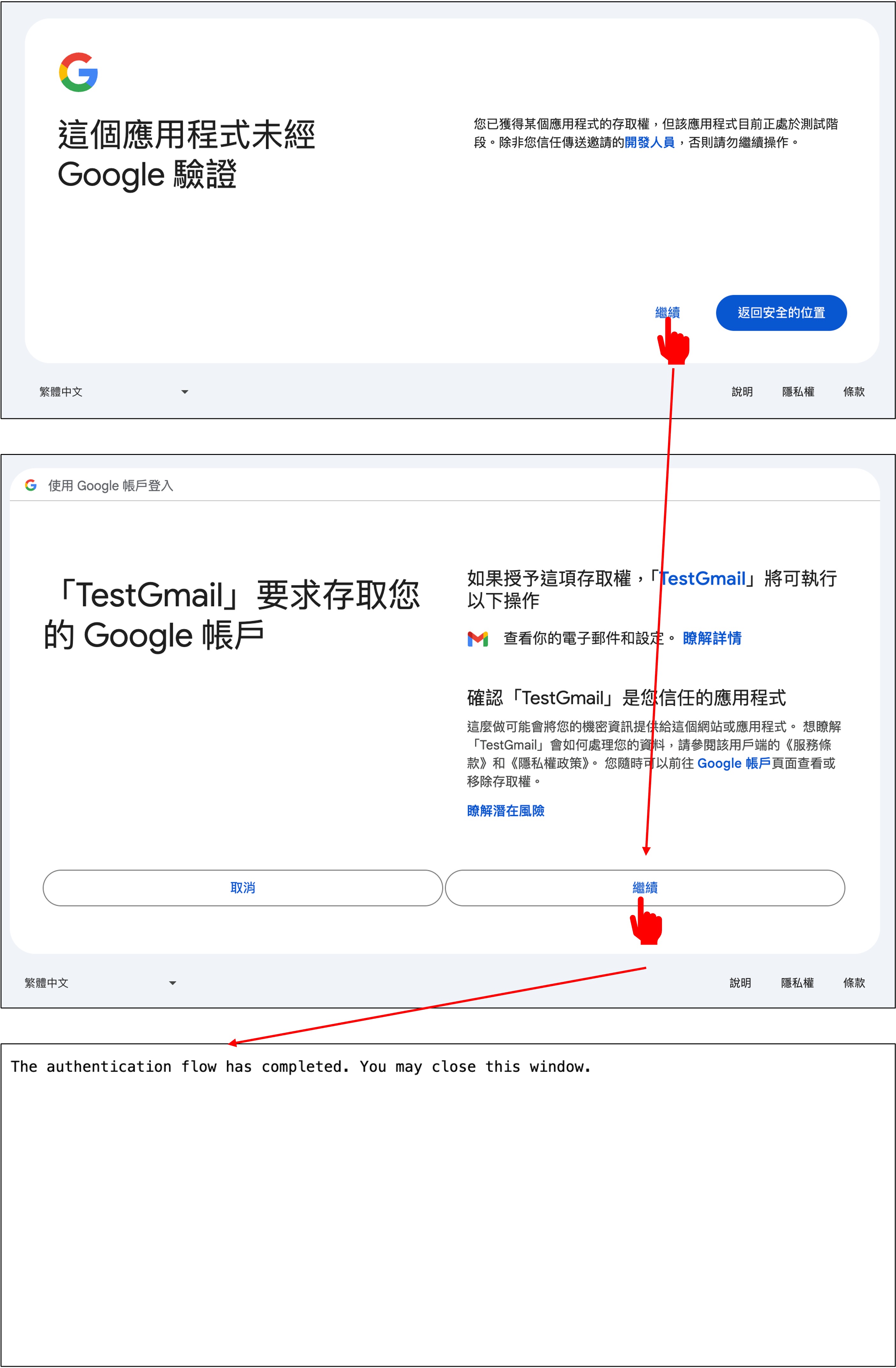Gmail API Calls
Now that the setup is complete, we can begin using the Gmail API.
First, locate the credentials.json file you downloaded earlier and place it in the root directory of your project.
Next, let's open Google's provided tutorial document: Python quickstart
Installing Dependencies
You need to install the Google client library for Python:
pip install -U google-api-python-client google-auth-httplib2 google-auth-oauthlib
Configuration Example
-
In your working directory, create a file named
quickstart.py.- You can directly reference the source code provided by Google: source code
-
Include the following code in
quickstart.py:quickstart.pyimport os.path
from google.auth.transport.requests import Request
from google.oauth2.credentials import Credentials
from google_auth_oauthlib.flow import InstalledAppFlow
from googleapiclient.discovery import build
from googleapiclient.errors import HttpError
# If modifying these scopes, delete the file token.json.
SCOPES = ["https://www.googleapis.com/auth/gmail.readonly"]
def main():
"""Shows basic usage of the Gmail API. Lists the user's Gmail labels."""
creds = None
# The file token.json stores the user's access and refresh tokens, and is
# created automatically when the authorization flow completes for the first
# time.
if os.path.exists("token.json"):
creds = Credentials.from_authorized_user_file("token.json", SCOPES)
# If there are no (valid) credentials available, let the user log in.
if not creds or not creds.valid:
if creds and creds.expired and creds.refresh_token:
creds.refresh(Request())
else:
flow = InstalledAppFlow.from_client_secrets_file(
"credentials.json", SCOPES
)
creds = flow.run_local_server(port=0)
# Save the credentials for the next run
with open("token.json", "w") as token:
token.write(creds.to_json())
try:
# Call the Gmail API
service = build("gmail", "v1", credentials=creds)
results = service.users().labels().list(userId="me").execute()
labels = results.get("labels", [])
if not labels:
print("No labels found.")
return
print("Labels:")
for label in labels:
print(label["name"])
except HttpError as error:
# TODO(developer) - Handle errors from gmail API.
print(f"An error occurred: {error}")
if __name__ == "__main__":
main()
Running the Example
Run quickstart.py:
python quickstart.py
When you run quickstart.py for the first time, it will prompt you for authorization. Click "Allow".

You'll see output similar to the following:
Labels:
CHAT
SENT
INBOX
IMPORTANT
TRASH
DRAFT
SPAM
CATEGORY_FORUMS
CATEGORY_UPDATES
CATEGORY_PERSONAL
CATEGORY_PROMOTIONS
CATEGORY_SOCIAL
STARRED
UNREAD
Additionally, a token.json file will be retrieved. This file will be used for subsequent runs of quickstart.py without needing to authorize again.
Getting Started
Next, we'll begin using the Gmail API to parse email contents.
We've implemented three parts: creating a client, fetching emails, and parsing emails.
First, import the necessary packages:
from base64 import urlsafe_b64decode
from datetime import datetime, timedelta
from typing import Dict, List
import pytz
from google.oauth2.credentials import Credentials
from googleapiclient.discovery import build
Creating a Client
When creating a Gmail API client, load token.json, which stores the user's access and refresh tokens, and automatically refreshes the access token when it expires.
def build_service():
creds = None
token_file = 'token.json'
creds = Credentials.from_authorized_user_file(
token_file, scopes=['https://www.googleapis.com/auth/gmail.readonly'])
service = build('gmail', 'v1', credentials=creds)
return service
Fetching Emails
Next, define a function to retrieve email contents from the client:
def get_messages(
service,
user_id='me',
after_date=None,
subject_filter: str = None,
max_results: int = 500
) -> List[Dict[str, str]]:
tz = pytz.timezone('Asia/Taipei')
if not after_date:
now = datetime.now(tz)
after_date = (now - timedelta(days=1)).strftime('%Y/%m/%d')
messages = []
try:
query = ''
if after_date:
query += f' after:{after_date}'
if subject_filter:
query += f' subject:("{subject_filter}")'
response = service.users().messages().list(
userId=user_id, q=query, maxResults=max_results).execute()
messages.extend(response.get('messages', []))
# Handle pagination with nextPageToken
while 'nextPageToken' in response:
page_token = response['nextPageToken']
response = service.users().messages().list(
userId=user_id, q=query, maxResults=max_results, pageToken=page_token).execute()
messages.extend(response.get('messages', []))
except Exception as error:
print(f'An error occurred: {error}')
if not messages:
print("No messages found.")
return messages
Parsing Emails
After retrieving the data, it exists with a lot of metadata. We need to parse it into a readable format.
def parse_message(service, msg_id, user_id='me'):
try:
message = service.users().messages().get(
userId=user_id, id=msg_id, format='full').execute()
headers = message['payload']['headers']
parts = message['payload'].get('parts', [])
email_data = {
'Date': None,
'Subject': None,
'Text': None
}
# Parse headers to get send time, subject, sender, and recipients
for header in headers:
if header['name'] == 'Date':
email_data['Date'] = header['value']
elif header['name'] == 'Subject':
email_data['Subject'] = header['value']
# Parse email body
for part in parts:
if part['mimeType'] == 'text/plain' or part['mimeType'] == 'text/html':
data = part['body']['data']
text = urlsafe_b64decode(data.encode('ASCII')).decode('UTF-8')
email_data['Text'] = text
break # Take only the first matching part
return email_data
except Exception as error:
print(f'An error occurred: {error}')
return None
Conclusion
With that, we've covered the basic usage of the Gmail API.
Don't run it yet as we still need to do some preparation work.
We need to integrate with the OpenAI API so we can send email contents to ChatGPT for analysis.